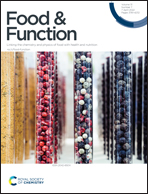A Lupinus angustifolius protein hydrolysate exerts hypocholesterolemic effects in Western diet-fed ApoE−/− mice through the modulation of LDLR and PCSK9 pathways†
Abstract
Lupin protein hydrolysates (LPHs) are gaining attention in the food and nutraceutical industries due to their several beneficial health effects. Recently, we have shown that LPH treatment reduces liver cholesterol and triglyceride levels in hypercholesterolemic mice. The aim of this study was to elucidate the effects of LPH treatment on the molecular mechanism underlying liver cholesterol metabolism in ApoE−/− mice fed the Western diet. After identifying the composition of the peptide within the LPH mixture and determining its ability to reduce HMGCoAR activity in vitro, its effect on the LDLR and PCSK9 pathways was measured in liver tissue from the same mice. Thus, the LPH reduced the protein levels of HMGCoAR and increased the phosphorylated inactive form of HMGCoAR and the pHMGCoAR/HMGCoAR ratio, which led to the deactivation of de novo cholesterol synthesis. Furthermore, the LPH decreased the protein levels of SREBP2, a key upstream transcription factor involved in the expression of HMGCoAR and LDLR. Consequently, LDLR protein levels decreased in the liver of LPH-treated animals. Interestingly, the LPH also increased the protein levels of pAMPK responsible for HMGCoAR phosphorylation. Furthermore, the LPH controlled the PSCK9 signal pathway by decreasing its transcription factor, the HNF1-α protein. Consequently, lower PSCK9 protein levels were found in the liver of LPH-treated mice. This is the first study elucidating the molecular mechanism at the basis of the hypocholesterolemic effects exerted by the LPH in an in vivo model. All these findings point out LPHs as a future lipid-lowering ingredient to develop new functional foods.



 Please wait while we load your content...
Please wait while we load your content...